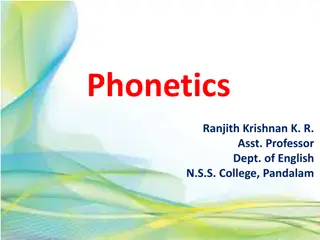Understanding English Consonant Sounds: A Detailed Guide
This guide delves into the English phonetics and linguistics classification of consonant sounds, emphasizing factors such as place of articulation and manner of articulation. It covers various types of consonant sounds, from bilabial and labio-dental to alveolar, post-alveolar, palatal, velar, and glottal, providing examples for better understanding. Dr. Prithiviraj Singh Chauhan's insights help clarify the distinction between voiced and voiceless consonants, offering an informative exploration of the basic speech sounds that shape English language pronunciation.
Download Presentation

Please find below an Image/Link to download the presentation.
The content on the website is provided AS IS for your information and personal use only. It may not be sold, licensed, or shared on other websites without obtaining consent from the author. Download presentation by click this link. If you encounter any issues during the download, it is possible that the publisher has removed the file from their server.
E N D
Presentation Transcript
Paper Nine: English Phonetics and Linguistics Classification of Consonant Sounds by Dr. Prithiviraj Singh Chauhan
Classification of Speech Sound: Consonant What is Consonant? A basic speech sound in which the breath is at least partly obstructed and which can be combined with a vowel to form https://www.lexico.com/definition/consonant All sounds during production of which we hear a friction are consonant, but not all consonant are produced with friction. Example: She,Ship,bat: a syllable.
Description of consonant A consonant is usually described, talking into account whether it is voiceless or voiced i.e. whether vocal cards are open or close Place of articulation: When two articulators come together to produce a sound at the different place in mouth. Manner of Articulation: It refers to the way in which the passage of air is restricted by various organs of speech.
Place of Articulation Bilabial: Two lips are articulator i.e. sound is produced with the help of two lips. Examples: pile, bile, mile (p,b,m) Labio-dental: The active articulator is lower lips and the passive articulators are the upper front teeth. Examples: fine, vine (f,v) Dental: The tip of tongue is active articulatorand the upper front teeth are passive articulator Example: thin, then (th, th)
Continue Alveolar: The tip or the blade of the tongue is active articulator and the teeth ridge is passive articulator Example: tin, din, near, sin, zip, love (t,d,n,s,z,l,) Post-Alveolar: The tip of tongue is the active articulator and the part of the roof of the mouth that lies immediately behind the teeth ridge is passive articulator. Example: Try, dry (r) Palato-Alveolar: The tip of the tongue or tip and blade is/are the active articulator(s) and the teeth ridge is passive articulator. Simultaneously, the front of the tongue is raised in the direction of the hard palate.
Continue.. Example: sheep, cheap, jeep ( sh,ch, jee,) Retroflex: The curled back tip of the tongue is the active articulator and the hinder part of the teeth ridge or the hard palate is the passive articulator. Example: , , , , , Palatal: The front of tongue is active and the hard palate is the passive articulator. Example: Yes (y) Velar: the back of tongue is the active articulator and the uvula is the passive articulator Example:
Continue Glottal: Vocal cards are the articulator Example: hat (h)
Manner of Articulation Plosive: Sound produced with a stricture of complete closer and sudden release is called plosive Examples: pin, bin,tin, kin, gun (p,b,t,g) For more information visit: https://thesoundofenglish.org/plosives/ Affricate: Sounds that are produced with a stricture of complete closure and slow release are called Affricare. Example: chin, jam (ch, j) For more information visit: https://thesoundofenglish.org/affricates/
Continue Nasal: Sounds that are articulated with a stricture of complete oral closure are called Nasal. Example: Sum, sun, sung (m, n, ng) For more information visit: https://thesoundofenglish.org/nasal-sounds/ Trill or rolled consonant: Sounds that are articulated with a stricture of intermittent closure are called trill or rolled consonant. Example: red, ran ( r )
Continue Fricative: Sounds that are articulated with a stricture of close approximation are called fricatives. Example: five, vine, thin, then, sip, sheep (f, v, th, th, s, sh) For more information visit: https://thesoundofenglish.org/fricative-consonants/ Laterals: Sounds that are articulated with a stricture of complete closure in the centre of the vocal tract but with the air escaping along the sides of the tongue without any friction are called laterals. Example: love (l)
Continue. Open Approximation: Sound that are articulated with a stricture of open approximation are called frictionless continuant or semi vowels. Example: yes, wet (y, w) Reference: Balasubramanian, T. (2002) A Textbook of English Phonetics for Indian Students. Delhi: Macmillan India Ltd. rpt.























